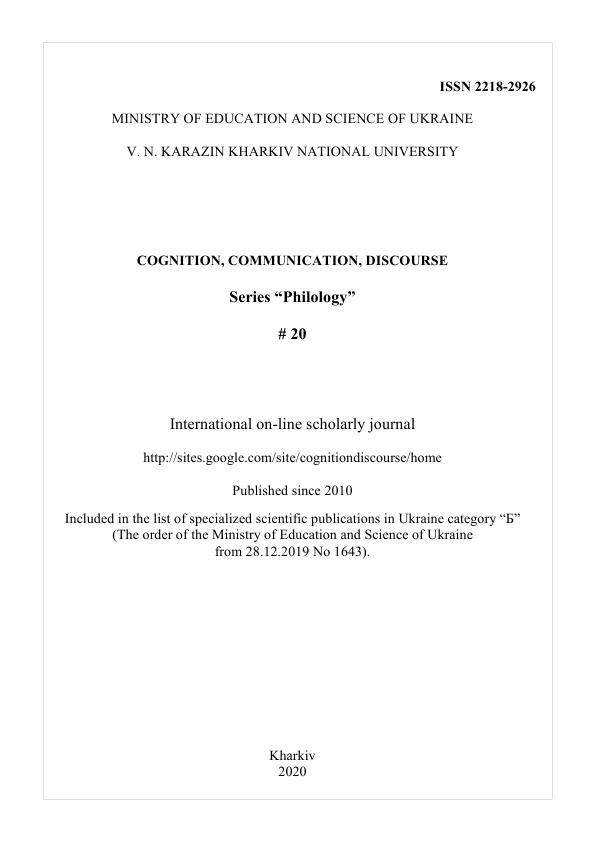Наративний мультимедийний концепт: алгоритм аналізу (на матеріалі інтернет-мемів про COVID-19)
Анотація
У статті, виконаній у руслі лінгвоконцептології та когнітивної теорії номінації, вирішуються актуальні для цих напрямів проблеми значення та способів його позначення. Загальний поняттєвий простір, конституйований значеннями вербальних і вербально-пікторальних мемів про COVID-19 (україно- та російськомовний матеріал) розглядається як наративний концепт і структурується за спеціальною методикою, яка дозволяє відтворити його онтологію, із притаманними їй тематичними сегментами, що мають різний ступінь акцентованості. Інтернет-меми на тему коронавірусу аналізуються в плані їхнього змісту (інтегрованого в тематичні сегменти наративного концепту) і в плані їхньої форми. У якості когнітивних технік створення змісту мемів розглядаються нарощування, розгортання, зштовхування та зв'язування. Семіотичними техніками творення мема як знака є прямі та переносні номінації. Останні вживають внутрішню форму знака, його зовнішню форму та внутрішню й зовнішню форми у взаємодії. Тема створення мема як знака доповнюється розглядом сміхових технік гіперболізації, парадоксалізації та абсурдизації, інтегрованих у зміст мема. У фокусі дослідження перебуває наративний концепт КОРОНАВІРУС як цільова сутність, що має особливу інтерпретацію і специфічні способи позначення. Окремою темою є концепт КОРОНАВІРУС як корелят, уживаний для характеристики низки інших понять.
Завантаження
Посилання
Comte-Sponville, A. (2001). Dictionnaire philosophique. Paris: Presses universitaires de France.
Fauconnier, G., & Turner, M. (2002). The way we think: Conceptual blending and the mind’s hidden complexities. New York: Basic Books.
Fillmore, Ch. (1982). Frame semantics. In The Linguistic Society of Korea (Ed.). Linguistics in the Morning Calm (pp. 111-137). Seoul: Hanshin Publishing Co.
Herman, D. (2009). Basic elements of narrative. Malden MA: Wiley-Blackwell. Retrieved from https://download.e-bookshelf.de/download/0000/5988/06/L-G-0000598806-0002339491.pdf
Herrmann, R. K. (2013). Perceptions and image theory in international relations. In L. Huddy, D. O. Sears, & J. S. Levy (Eds). The Oxford handbook of political psychology (p. 334–363). Oxford University Press.
Kovecses, Z. (2002). Metaphor: A practical introduction. Oxford: Oxford University Press.
Kulikov, L.V. (2009). Predislovie k russkomu izdaniyu. Martin R. Psikhologiya yumora: per. s angl. pod red. L.V. Kulikova [Preface to the Russian edition. Martin R. Psychology of humor: transl. from English / L.V. Kulikov (Ed.)] (pp. 11-14). SPb: Piter.
Langacker, R.W. (2008). Cognitive grammar: a basic introduction. Oxford: Oxford University Press.
Mann, W. C., & Thompson, S. A. (1988) ‘Rhetorical structure theory: Towards a functional theory of text organization’. Text, 8, 243-281.
Martin, R.A. (2007). The psychology of humor: an integrative approach. Amsterdam: Elsevier Academic Press.
Martynyuk, A. P. (2007). Kognitivnye mekhanizmy sozdaniya smekhovogo effekta v angloyazychnom anecdote [Cognitive mechanisms for creating a laughable effect in an English-language joke]. Kul'tura narodov prichernomor'ya,110 (2), 22–24.
Mineau, G. (2000). The engineering of a CG-based system: fundamental issues. In B. Ganter & G. W. Mineau (Ed.). Conceptual structures: logical, linguistic, and computational issues (pp. 140–56). Berlin: Springer Verlag.
Minsky, M. (1984). Jokes and the logic of the cognitive uconscious. In L.Vaina, & J. Hintikka (Eds). Cognitive constraints on communication. Dordrecht: Springer., 175-200. doi https://doi.org/10.1007/978-94-010-9188-6_10
Ozhegov, S. I. (1983). Slovar' russkogo yazyka / pod red. N.Yu. Shvedovoy [Russian dictionary / N. Shvedova (Ed.)]. M.: Russkiy yazyk.
Rushkoff, D. (1996). Media virus! Hidden agendas in popular culture. New York: Ballantine Books.
Ryan, M. L., & Thon, J.-N. (2014). Storyworlds across media: Introduction. In M.-L. Ryan, & J.-N. Thon (Eds). Storyworlds across media: toward a media-conscious narratology (pp. 1–24). Lincoln and London: University of Nebraska Press.
Sowa, J. F. (2001). Building, sharing, and merging ontologies. Retrieved from http://www.jfsowa.com/ontology/ontoshar.htm
Zhabotynskaya, S. A. (2013). Imya kak tekst: kontseptual'naya set' leksicheskogo znacheniya (analiz imeni emotsii) [The name as a text: a conceptual network of lexical meaning (analysis of the name of emotion)]. Cognition, communication, discourse, 6, 47–76. doi: https://doi.org/10.26565/2218-2926-2013-06-04 (in Russian)
Zhabotynskaya, S.A. (2017). Narrativnye politicheskie kontsepty: metodika lingvokognitivnogo analiza [Narrative political concepts: methods of cognitive linguistic analysis]. Kontsepty i kontrasty: monografiya / N.V. Petlyuchenko (Ed.). Odessa: Izdatel'skiy dom “Gel'vetika”,
30-40 (in Russian)
Zhabotynskaya S. A. (2018). Generativizm, kognitivizm i semantika lingval'nykh setey [Generative linguistics, Cognitivу linguistics, and Semantics of Lingual Networks]. Doctrina multiplex, veritas una. Uchen` bagato, isty`na odna: Kyiv: Ky`yiv, un-t im. B. Grinchenka. 99–141 (in Russian)
Zhabotynska, S., & Velivchenko, V. (2019) New media and strategic narratives: the Dutch referendum on Ukraine – EU Association Agreement in Ukrainian and Russian Internet blogs. European Security, 28(3), 360−381. doi: https://doi.org/10.1080/09662839.2019.1648253
Zhabotynska, S., & Slyvka, N. (2020). Emotive speech acts and their discourse modifications in the literary text. Discourse and Interaction. 13(1), 113− 36. doi https://doi.org/10.5817/DI2020-1-113.
Авторське право (c) 2020 Жаботинська Світлана Анатоліївна

Цю роботу ліцензовано за Міжнародня ліцензія Creative Commons Attribution-NonCommercial-NoDerivatives 4.0.
Автори, які публікуються у цьому журналі, погоджуються з наступними умовами:
Автори залишають за собою право на авторство своєї роботи та передають журналу право першої публікації цієї роботи на умовах ліцензії Creative Commons Attribution License (CC BY), яка дозволяє іншим особам вільно розповсюджувати опубліковану роботу з обов'язковим посиланням на авторів оригінальної роботи та першу публікацію роботи у цьому журналі.
Автори мають право укладати самостійні додаткові угоди щодо неексклюзивного розповсюдження роботи у тому вигляді, в якому вона була опублікована цим журналом (наприклад, розміщувати роботу в електронному сховищі установи або публікувати у складі монографії), за умови збереження посилання на першу публікацію роботи у цьому журналі.
Політика журналу дозволяє і заохочує розміщення авторами в мережі Інтернет (наприклад, у сховищах установ або на особистих веб-сайтах) рукопису роботи, як до подання цього рукопису до редакції, так і під час його редакційного опрацювання, оскільки це сприяє виникненню продуктивної наукової дискусії та позитивно позначається на оперативності та динаміці цитування опублікованої роботи (див. The Effect of Open Access).




